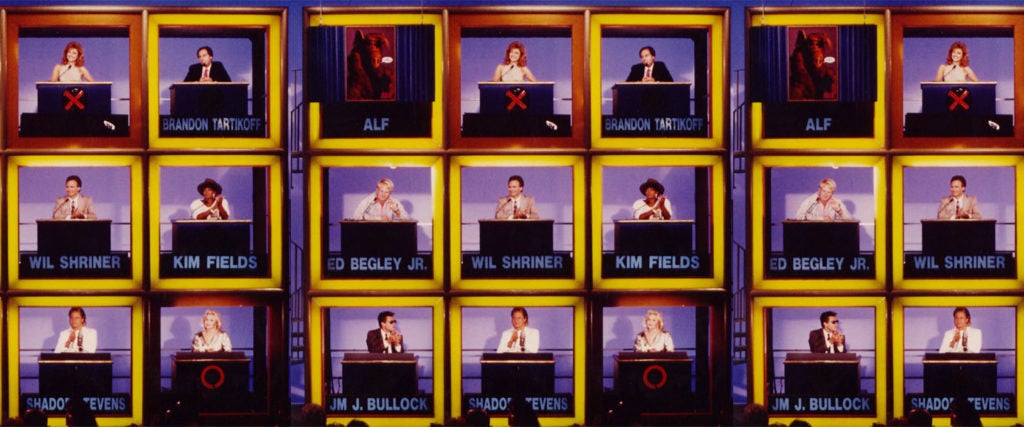When the ABC sitcom Too Close for Comfort was abruptly canceled in 1986 following Ted Knight’s death from cancer, cast member Jim J. Bullock found himself suddenly jobless with no leads. Rather than hang around L.A. with nothing to do, the 31-year-old Texan hopped in a red Corvette with his best friend Bruce Dent for a months-long, cross-country road trip. “We talked a lot about what Jim was gonna do next,” Dent recalls, given that casting agents were completely ignoring the zany, gay jokester.
Six weeks later, from a payphone on the outskirts of Phoenix, Bullock finally checked his home answering machine and discovered dozens of frantic messages from his agent. “Why aren’t you picking up your phone?!” she squawked. “Hollywood Squares wants you as a regular!”
The New Hollywood Squares (TNHS) was a syndicated game show that aired at 7:30 p.m. in most U.S. markets from 1986 to 1989. Two contestants, a man (X) and a woman (O), competed in a game of tic-tac-toe by calling on nine celebrities seated three-by-three on a giant board, each of whom were asked a trivia question. Most responded with a “zinger,” a seemingly off-the-cuff one-liner written by the TNHS writing staff, before offering a final answer, with which contestants either agreed or disagreed. If correct, they earned the square; if not, their opponent did. The object, like tic-tac-toe, was to get three in a row. The person with the most money at the end of the game selected one of five car keys from a cereal bowl, then a car. If it started, it was theirs.
The original Hollywood Squares ran from the mid-1960s until 1981, dominating daytime ratings in a powerhouse NBC game-show bloc including Concentration, Jeopardy!, You Don’t Say!, Let’s Make a Deal and Match Game. The host, television and radio personality Peter Marshall, the consummate straight man, teed up jokes in the form of trivia questions for center square Paul Lynde to casually knock out of the park.
In the mid-1980s, Rick Rosner, creator of CHiPs, acquired the rights to the show and planned to blow the roof off of the stale, mid-century version by incorporating visual clues, musical interludes and extensive set pieces. “We wanted to be more outlandish,” explains Rick Shaw, one of four men on TNHS writing staff. “Our guiding principle was to be a bit more rock-and-roll with everything we did.”
The baby-faced host of TNHS, actor/singer John Davidson, and his luscious mop of adorably coiffed brown hair, was a mainstay on the variety show circuit throughout the 1970s and early 1980s, with multiple stints on The Ed Sullivan Show, The Carol Burnett Show and The Sonny & Cher Comedy Hour. He learned what made for an ideal Hollywood Squares host — run the game, set up the joke and stay out of the way — while appearing more than a hundred times on the original version.
For young Gen Xers, The New Hollywood Squares was a reliably weird and occasionally entertaining backdrop to our prepubescent evenings. On most weeknights of Ronald Reagan’s waning years in office, shortly after Brokaw and just before The Cosby Show, American television sets broadcasted impromptu mini cabarets disguised as a back-of-the-envelope children’s game.
“It’s certainly left one of the biggest footprints,” agrees game-show historian and author Adam Nedeff, citing the ubiquity of TNHS clips on YouTube. “Since the dawn of the internet, Hollywood Squares has been kept alive on Facebook and email forwards, thanks to the tightness of the writing and execution of it.” Media scholar and television historian Robert Thompson puts it on the level of “classic game shows,” alongside The Price Is Right, Wheel of Fortune and Jeopardy!.
Only three television networks existed when TNHS premiered in 1986, and Prime Access (i.e., the 7 to 8 p.m. weekday time slot reserved for local or syndicated programming) was considered king. As such, TNHS was an instant, monster hit, with nearly eight percent of people in the U.S. with television sets tuning in. (For context, the top-rated scripted broadcast of 2019, The Big Bang Theory finale, only averaged about half that, which Variety called a “ratings bazinga.”)
Up-and-coming celebrities yearned for invitations to appear on the new Squares, comparing the exposure to The Tonight Show. “There have always been unlikely status symbols on TV,” Thompson explains. “Appearances on Sesame Street remain one, as does guest-voicing a character on The Simpsons. In the late 1980s, it was Hollywood Squares, and it was a very hip call to receive.”
“It was kind of like, I’ve arrived,” recalls Tony O’Dell, a cast member on the ABC sitcom Head of the Class, who appeared on 10 episodes of TNHS. “I was being acknowledged as somebody who had ever-so-slightly made it on television.”
While other game shows like What’s My Line? also included famous guest stars, there were never more than three. TNHS, on the other hand, had a towering panel of nine celebrities, of all sorts, too — from comics, to musicians, to B-list movie stars, to puppets, to athletes, to weathermen. And so, on any given night, viewers might find Tony Danza playing alongside Little Richard, Kareem Abdul-Jabbar, Willard Scott, Dr. Ruth, a random person from Night Court and Big Bird. Joan Rivers held down the center square, with series regulars Phyllis Diller, Richard Simmons and ALF rounding out the corners.
As Bullock gunned his red Corvette westward on Interstate 10, he beamed with anticipation. “I had absolutely nothing, and then Hollywood Squares happened,” he gleefully recalls. “Suddenly, I was working four days a month, with no lines to learn. Joan [Rivers], John [Davidson], Shadoe [Stevens] and all of these wonderful people and I became a family that played a stupid little game every other weekend. Too Close for Comfort will always be my favorite show because it was my first. But I’ll never have more fun than I did on Hollywood Squares.”
* * * * *
The pilot of TNHS was shot on Stage Three at NBC Studios in Burbank, down the hall from The Tonight Show with Johnny Carson.
Bob Loudin, director, 1986-1988: Dom DeLuise was in the center square. Rick [Rosner] went and shot some home movies of these “state-of-the-art trash cans” in Beverly Hills that garbage trucks picked up and flipped. Nobody had seen those before! He said, “Let’s fly one in, have it painted with a clown face on it. We’ll ask the square, ‘What is this?’” It’ll pay off with a truck dumping a “genuine Beverly Hills trash can” in the alley. That’s the kind of thing we were thinking about for the pilot.
John Davidson, host, 1986-1989, as recorded on The Nite Show With Danny Cashman: My agent came to me in 1986 and said, “We’ve got that television series for you that you’ve always wanted.” I said, “Great!,” thinking I was going to be in the musical version of The Six Million Dollar Man. “No, there’s no singing at all,” he said. “You’re gonna host a game show, Hollywood Squares, and the center square isn’t Paul Lynde, it’s Joan Rivers.” I’d always admired Joan because she acted dumb, but she was Phi Beta Kappa at Barnard College. So smart, and such a hard worker, so I said, “Sure, why not?”
For an announcer, Rosner turned to radio disc jockey Shadoe Stevens, director of programming for KROQ (“K-Rock”) in L.A., whose booming baritone and leading-man looks led to an announcer/sidekick gig on The Steve Allen Show. Most, though, knew him as Fred Rated, the tongue-in-cheek frontman of a series of massively successful commercials for Federated Home Electronics in California.
Shadoe Stevens, announcer, 1986-1989: Rick first put me on TV back in Boston as a youth correspondent for Dave Garroway’s Tempo Boston. He told me he was bringing back Hollywood Squares with John Davidson as host and asked me to help him out for the pilot. I said, “Sure, but I really don’t wanna be an announcer anymore.”
While shooting the pilot, Rosner convinced Johnny Carson to walk across the hall for a cameo.
Steve Grant, assistant director, 1986-1988; director, 1989: It was a coup to have Carson on a show that hadn’t even aired yet.
Loudin: We were going to bring Johnny on as a “visual clue” for whomever was to answer the next question. When he started walking across the hall, it happened that the next question was for Burt Reynolds, so we set a stool upstage of Burt in the lower right square.
The question was, “Even though it can bring about an occasional blister, the man you see before you does something as often as he can, and openly admits it brings him tremendous pleasure.” To uproarious laughter, Carson added, “Sometimes I use two hands, but as you get older, you find it’s easier and more effective with one.” (The answer, of course, was… “play tennis.”)
Loudin: When the gal came out to escort Johny off, the little look he does when he glances down at her boobs was spot-on. I mean, just perfect.
Perfect, perhaps, for 1986. But emblematic of the many TNHS moments that haven’t aged particularly well. Like most television from the 1980s, glaring blind spots regarding gender and race abound.
Marsha Warfield, actor, Night Court and The Richard Pryor Show; five TNHS appearances: The expectation was that I would be the only [African American] in a given situation. And most often, that was true. I recall Jeffrey Osborne and some other Black performers being on Squares, but rarely together. We never broke the quota, you know what I mean? We were in the realm of what was going on at the time.
Daphne Reid, actor, The A-Team, WKRP in Cincinnati, Hill Street Blues, The Fresh Prince of Bel-Air; five TNHS appearances: I wasn’t the only [African American] on my Hollywood Squares episodes. Jimmie Walker (J.J. from Good Times) was in some of them, too. The show felt like the racial profile of the early 1980s — meaning there wasn’t a big focus on making sure there were Black people in projects. But every once in a while, it happened.
In any event, the TNHS pilot was instantly greenlit for production.
Stevens: Rick asked me to be the announcer, and I said no. I had a chance to be an actor, and I wanted to take a shot at it. He came back to me again, and I turned him down again. Then he came back once more and said, “How ’bout if we put you in a square and you do the announcing from there? It would be kind of quirky and fun and different. Then if you’re doing a movie or something, you can promote it.” I agreed. Suddenly, it’s the biggest hit of the year, an absolute monster. I was only supposed to be on a couple of shows a week, but I was really well-received. It was a peak moment of my life, and I was clicking with people.
It was my job to go out there and do over-the-top, bombastic announcer things, which was fun. I could be as broad as I wanted with the announcer thing. I threw in a little B.B. King growl when announcing John and stretched it out, like, “Joooooooooooohn Davidson!!!!” It was really over-the-top.
Loudin: Rick wanted this to be different from old, stale game shows. We were gonna have visual clues. We were gonna have surprises. He wanted it to be so that you never knew who you’d find if you tuned in — a marching band in the studio? Little Richard singing “Long Tall Sally”? Someone wrestling an alligator in the Bahamas? That required an extended square sometimes so we could fit all of The Andrews Sisters, The Four Tops or Tommy Smothers soaking in a hot tub.
Adam Nedeff, game-show historian and author: They really gussied up the set pieces, sometimes having Bob Denver and Alan Hale Jr. sharing a square designed to look like the lagoon from Gilligan’s Island. They had Wolfgang Puck in a functioning kitchen, all three network weathermen, New Edition and Phyllis Diller in bed with Regis.
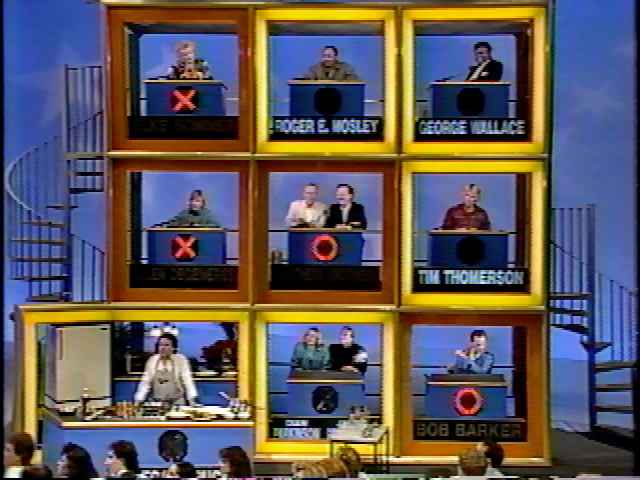
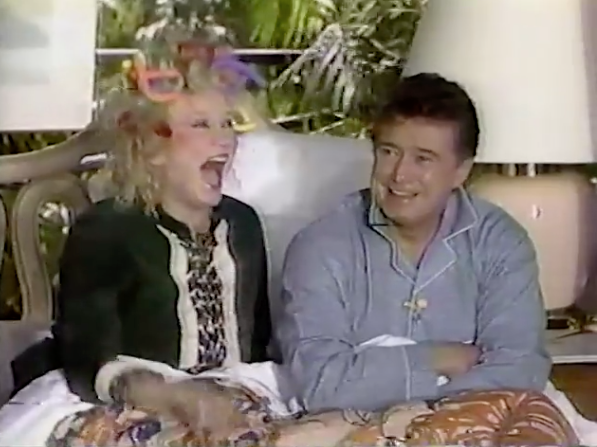
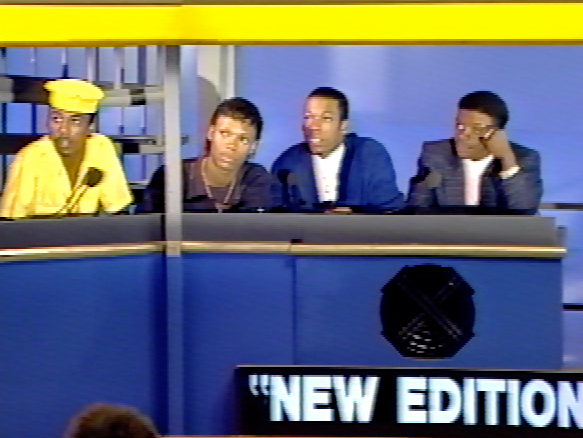
Grant: We wanted it to feel like a dining room table. When extra people showed up, we just put another leaf on the table to make room.
Tony O’Dell, actor, Head of the Class; 10 TNHS appearances: Hollywood Squares was really just a new iteration of Battle of the Network Stars, which started this whole genre of television personalities coming together casually. The creators of Dancing With the Stars definitely had Hollywood Squares on their mind when they pitched it.
Robert Thompson, media scholar and television historian: And it was a way to cross-promote projects. There were a lot of scripted things like this in the 1980s — Fantasy Island, Love Boat, Murder She Wrote. Before reality TV, things like this drew great ratings. Hollywood Squares was a natural evolution.
The average American viewer, however, never realized the whole thing had been written beforehand.
Rick Shaw, TNHS writer, 1986-1989: Even people in show business were like, “Those jokes were written?”
Grant: Questions were catered to the star, so if you had Dom DeLuise or Louis Anderson, you might write something about whales because a lot of their humor was about being overweight.
Shaw: The stars wouldn’t know what question was coming to them, but they would know the topic of the question. We wrote them a joke answer, referred to as “zingers,” and a wrong, “bluff” answer, so they wouldn’t sit there with egg on their face.
We were young, wise-ass comedy writers. We’d spend all day writing and researching questions. Harry Friedman, who went on to executive produce Wheel of Fortune and Jeopardy!, would pick questions and we’d sit around like the old Dick Van Dyke Show, pitching jokes for celebrities who were on that week. This was before the internet, of course, so we’d look at encyclopedias, newspapers and books of trivia. So if Richard Simmons was going to be on the show, we’d get some sort of cookbook or nutrition book, and look up various facts about whatever the topic was.
Thompson: Richard Simmons was the perfect person for Hollywood Squares, because the best squares were people who were funny by simply opening their mouth.
Shaw: Richard and I had a very special relationship. He’d send me the most beautiful bouquet of flowers. I haven’t gotten flowers like that from anyone in my life since. He also gifted me a Dalmatian.
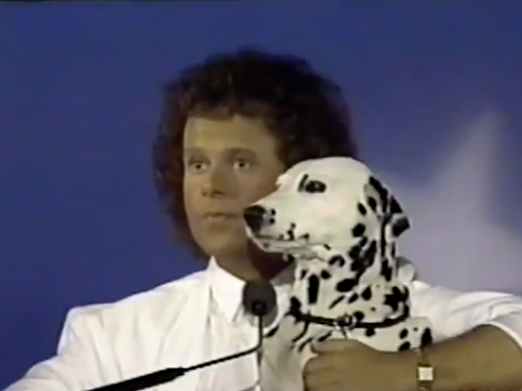
The thing was, in the original Hollywood Squares, only the comedians got jokes. But Rick said, “We’re giving everybody jokes,” which was difficult sometimes. I briefed Mary Lou Retton, the Olympic gold medalist, and she was like, “This isn’t going to be funny.” Her first joke kind of bombed, because it actually wasn’t funny. I went up and whispered, “After you deliver the joke, take a beat and put your arms up like you just landed a flip.” So she told her joke, stuck the landing and threw her arms in the air — to a standing ovation. Huge applause.
Mary Wilson, founding member of The Supremes: I’d watched the old Hollywood Squares many times, and it seemed like everyone was so funny and dead-on with everything. I’m a singer, not a comedian, so I was concerned I wasn’t going to be up to par. Thankfully, they asked me to sing.
Grant: Stormy Sacks, our musical director, would accompany Florence Henderson, Mary Wilson or Debbie Gibson, and could change the key on the fly.
Stormy Sacks, TNHS musical director, 1986-1989: Every time a singer would come on, they needed to do 30 seconds of a song, with a beginning, middle and end. And it had to sound like their original track.
Wilson: They asked me to sing “Baby Love.” I think I did quite well. Jim J. Bullock made me feel a lot better.
Jim J. Bullock, TNHS regular, 1986-1989: I heard Debbie Gibson on Sirius recently, and it was her 50th birthday celebration. I was reflecting back on when she was on Hollywood Squares and she had that hit song, “Shake Your Love.” I adored her. I thought, Oh, my God, she turned 50?! So I’m subtracting 35 years from that, and I’m like, How young was Debbie when we did Squares?
Debbie Gibson: I was only 17, so it was a unique kind of pressure. But I welcomed any chance to do what I do, and remember singing “Shake Your Love” with my high school friends in the audience, which was so fun.
Shaw: It was an incredible cavalcade of celebrities on this silly little show. We’d get stars from shows like Dallas, Dynasty and Falcon Crest because they could come on and show a different, more fun side of themselves. For a few years there in the 1980s, every B-list celebrity wanted to be on a game show.
The first season of TNHS was taped at the aforementioned NBC Studios, and then moved to Fox Studios for Season Two and Universal Studios for Season Three.
Grant: We shot on Sundays and Mondays. The Sunday taping was for all of the stars who had Monday through Friday gigs, and the Monday taping was for all the stars who didn’t want to work on the weekend.
Reid: It was a week’s worth of shows in one day. Three before lunch, and then two more.
Loudin: Rick produced everything, including the experience for the celebrities. At dinner, we had Squares tablecloths printed and the whole place decked out. The staff ate dinner with celebrities, like a big family meal.
Grant: Everyone was just hanging out. It wasn’t A-list people with entourages keeping people away.
Wil Shriner, comedian; 10 TNHS appearances: You’ll notice the Monday, Tuesday and Wednesday shows aren’t as loose and raucous as the Thursday and Friday ones. We had a meal break after the third show and there was an open bar, so that always loosened people up.
Stevens: The only frustration was that you had to bring five changes of clothes.
Reid: We were paid the AFTRA minimum rate, roughly $450 per day at the time, and there was a hierarchy in the square presentations. Comics were always in the center. The rest of us were just peripherals, like candy.
Nedeff: Little known fact: SAG-AFTRA sets pensions based on the number of episodes of TV shows you do. So when you do a day on Hollywood Squares, that’s five episodes added to your till for your pension. Jamie Farr, from M*A*S*H, collects a gigantic pension, and what boosted the numbers were all those game shows he did in the 1970s and 1980s. You don’t get rich doing game shows, but you’re definitely looking out for your future self.
Susan Ruttan, actor, L.A. Law; five TNHS appearances: It wasn’t about the money, it was about demonstrating that you were smart and funny. Actors want to be appreciated, we want to be liked, we want the audience to love us and we want to please. Hollywood Squares was a perfect setting for that.
The original set, which had been in storage in Las Vegas, was destroyed a year before the pilot was shot because payment stopped on the storage unit. So Rosner’s team built a new one from scratch.
Grant: It was a 30-foot tic-tac-toe board, three levels high. Home base, where John and the contestants were, was level with the second row of squares. The squares were big enough for a large person, because we had professional football players and basketball players and they had to fit comfortably. Technology was further advanced, so the Xs and Os were neon instead of backlit light boxes. The left spiral staircase went up to the third row and the right staircase to the second row.
Warfield: You had to walk up those doggone steps to get to your square, and it was like climbing a fire escape.
Loudin: Women usually would take their heels off to go up, and then put their heels back on. Since you never saw their feet, many wore comfortable shoes. You could wear flats on Hollywood Squares.
Thompson: Joan Rivers settled into the middle square, which made perfect sense.
Grant: Joan came on after her husband [producer Edgar Rosenberg] committed suicide. Needless to say, she was quite distraught. TNHS was healing for her because it was a family atmosphere. I remember Joan coming to the studio to see the space and where her square would be. No audience, no crew, no makeup, no wardrobe. Just Joan Rivers, the woman. She had a really soft and gentle look about her when she wasn’t doing her act.
Stevens: I did a romantic parody of From Here to Eternity with Joan where we were lovers rolling in the sand. It was hilarious. After every take, she would squirt Binaca in her mouth because she had this phobia about bad breath. On the show, she had people who would look up stuff to help her prepare. She was a real workhorse.
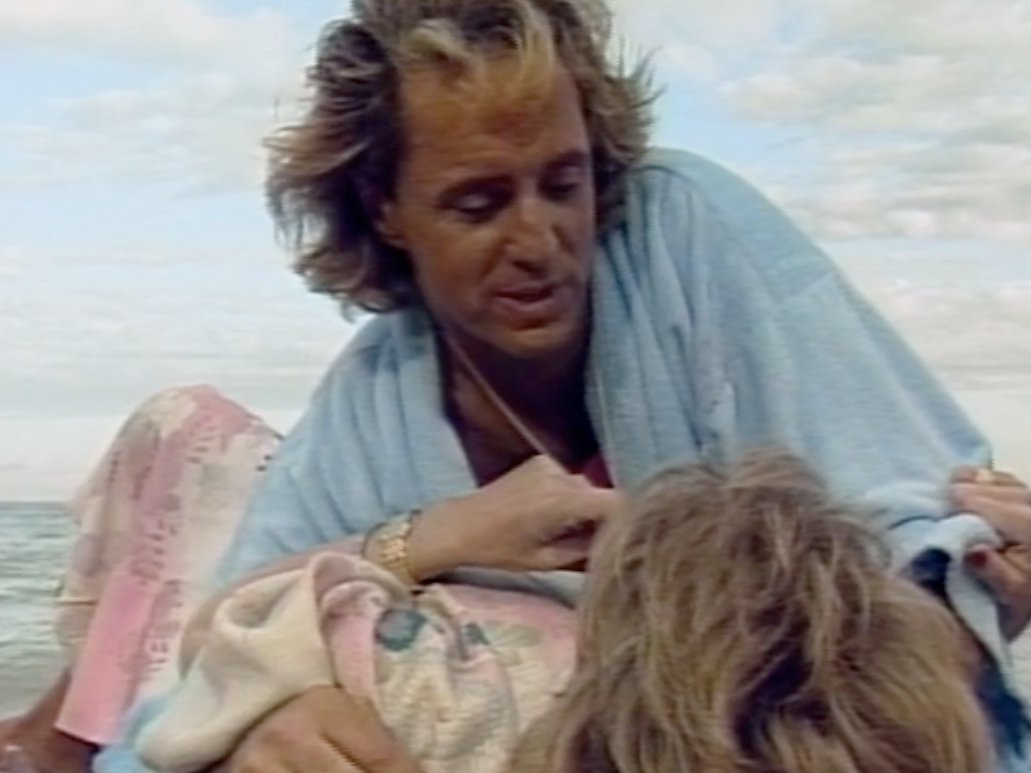
Thompson: Phyllis Diller had been around forever, but still had that kind of edgy, bizarro comedy to her. Then there was Jim J. Bullock, from Too Close for Comfort, who curiously used to spell his name without the “i” for some reason.
Bullock: It’s because there was another Jim Bullock in the union. As a young, naive, totally green kid off the farm, I thought it would help me stand out. Joan Rivers’ manager, Billy Sammeth, managed me from the Squares years until the mid-1990s and suggested I put the “i” back. It’s one of the few regrets I have in my life.
Grant: I remember Jim climbing and hanging upside-down from his square to peek into the square below. It was amazing. He’d take a pair of styrofoam cups and make them into cat ears or whatever.
Stevens: Jim J. Bullock is just a funny motherfucker. Fearless, reckless and impulsive. He’d be running between squares, hanging upside-down out of a square, or saying something spontaneously outrageous in response to someone’s answer. He elevated the entire energy of the whole room every day, every show. He was remarkable.
Bullock: I used that set like monkey bars, crawling into other people’s squares. I did some crazy shit-ass stuff, because if I fell, I could’ve really hurt myself. But I was fearless then — and a lot thinner.
Loudin Jim was always good for a laugh. We brought in an airplane behind him once on the big screen. The question was, “You have two wands there. What do you do to stop an airplane on the runway?” And of course, the plane runs into the squares and we shake the camera, and Jim takes a dive behind the counter.
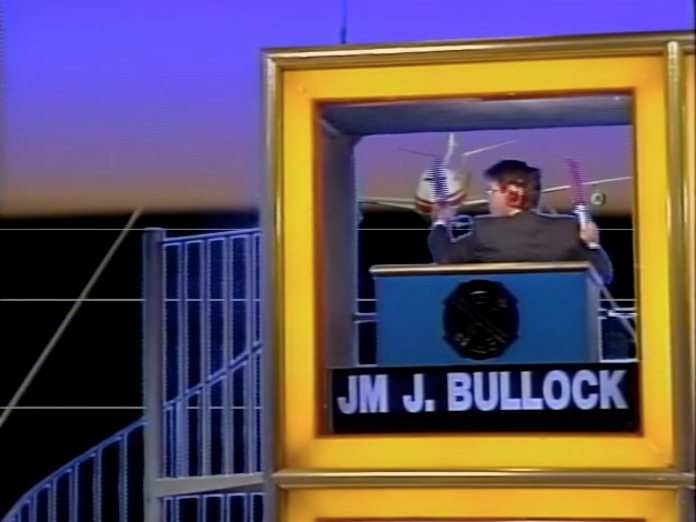
Loudin: One day we had a mannequin with a stewardess’ outfit on in his square for a question. Well, of course, by the end of the show, guess who was wearing the stewardess’ outfit, screaming “Mama, I’ve changed!!!”
Bullock: I was fearless in many ways. I also find my younger self to be very obnoxious and absolutely scene-stealing, especially with Glen Campbell. Oh my God! Poor Glen!!!
Thompson: Because there were nine panelists, they were able to choose big-time movie stars, but also some novelty choices. In that sense, it reminds me a little bit of Dancing With the Stars. Look at the names with five or more episodes on TNHS: Louie Anderson, Vincent Price, Betty White, Gladys Knight, Bob Costas, Mr. T, Big Bird, Kareem Abdul-Jabbar, Jerry Seinfeld, Marsha Warfield, Zsa Zsa Gabor…
Bullock: Whenever there was no toilet paper, you knew Zsa Zsa had ransacked the dressing room.
Bruce Dent, Jim J. Bullock’s best friend: She would steal light bulbs, lamps, anything that wasn’t bolted down. They ended up putting her in a dressing room with nothing but a chair and a mirror. It was so odd to me, because she looked so glamorous.
Shaw: Zsa Zsa Gábor once threw a hairdryer at me. She said, “These are not fucking jokes!,” and hurled it. Fortunately, it was plugged in and bounced back.
Sacks: Zsa Zsa didn’t want to sit next to ALF at all.
Davidson: She asked ALF, “Do you bite?” And he said, “That’ll be $5 extra.”
Paul Fusco, creator and voice of ALF: Hollywood Squares was the perfect vehicle for ALF, as he was able to be spontaneous and “off the page.” Rick Rosner once told me that they got their highest ratings when ALF appeared. They were always trying to book him on the show whenever it was sweeps week.
Nedeff: I recently made a note of a TNHS episode with the most 1986 panel possible: Alf, Ed Begley Jr. from St. Elsewhere, Tempestt Bledsoe from the The Cosby Show, Nell Carter from Gimme a Break, Christopher Hewett from Mr. Belvedere and Ken Kercheval from Dallas. These were big, prime-time stars from hit shows, and it was fascinating to see them collected in one place. A show like this is such a time capsule.
Despite the executive producer (Rosner), director (Loudin), assistant director (Grant) and series regular (Bullock) being gay, like most Hollywood sets in the 1980s, “don’t ask, don’t tell” ruled the day.
Loudin: Nobody asked, and nobody really told. Of course, there were gay men and women on every show, and some celebrities who are out and some celebrities who weren’t. It wasn’t an issue one way or the other, because it just was. Look at Paul Lynde. I remember my mom insisting how he wasn’t gay. So you sort of knew, but you didn’t know. Same with Jim J. Bullock.
Bullock: In 1986, they thought it would be great for me to do a pie-in-the-face bit with Milton Berle. So on the dinner break, they talked with Milton and me privately. I was beside myself that they wanted me to do a bit with him. I mean, this was Mr. TV! They said, “Crawl down to Milton’s square and just gush over him, saying, ‘Milton Berle, you’re the best…” I was like, absolutely, whatever you need. Then Milton looked at me and said, “Do exactly what I tell you, kid, and none of this fag shit.”
Grant: I can picture Milton saying that.
Loudin: I absolutely can.
Bullock: I was nowhere near out, or comfortable with myself, so when Milton Berle says, “None of this fag shit,” you say, “Yes, sir, okay, I won’t.” I did exactly what he told me to do, which was to stand there with this stupid look and let him slam the pie in my face, ignoring all my comic intuitions. But then it was totally flat, un-spontaneous and bombed. Zero laughs. So I had to crawl back up to my square with whipped cream running down my chest and sticky underwear — and in not a good way either.
I’d come from Too Close for Comfort. Ted [Knight] knew I was gay, but was never comfortable with it. It was unspoken, very much like a father-son. So Ted would say, “Bring it down a couple of mince.” I knew what he meant by that, so I’d try to butch it up. But when I got to Hollywood Squares and they were so comfortable with me and who I am naturally, the more I was myself, the more successful I became.
Dent: It was a really supportive, inclusive environment.
Bullock: Which was super duper refreshing. Rick would come to me every once in a while, truly concerned for me and my career. He’d say, “Jim, sometimes you push the line, and I’m just afraid that you’re going to hurt yourself. Because this show is going to end, and I don’t want you to end your career on Hollywood Squares. You need to pull back a little.” But John [Davidson] would step in and say, “Don’t tell Jim to pull it back! Let him do what he does. If he edits himself, it’s not spontaneous anymore.” Which was very smart of him.
At the peak of TNHS’ popularity, Rosner took the show to New York City, where it received its highest ratings, for a week of shows at Radio City Music Hall.
Loudin: We wanted to do what we always did and just give out a bunch of free tickets. But come show day, people had lined up 10 deep all the way around the block. They lapped around the entire Radio City Music Hall facility. David Letterman had his office across the street and leaned out of his window with a bullhorn, announcing, “People of New York go home! There’s nothing to see here!”
Shaw: Joan’s first joke happened to be mine, and she got a huge response from it. The question was, “Joan, how much is the current toll on the New Jersey Turnpike?” Her answer: “Half of my last divorce.” Having a joke that I wrote said by Joan Rivers at Radio City Music Hall was a major thrill for me. Joan looked down at me and gave a wink, like, You did good, kid.
Stevens: Rick came up with this idea to have a marching band coming down the aisles playing “New York, New York,” which almost brought me to tears.
Sacks: I had to put a track of Radio City’s famous Wurlitzer organ on top of the original music. When you play those organs, you can’t listen to yourself because the sound happens about quarter of a second after you play. So you just have to start and keep going. Oh my God, it was hard.
In the end, though, what helped Hollywood Squares get on the air is also what cut its run short, as it was canceled in 1989.
Nedeff: Everyone was trying to get a game show on the air to get a chunk of that Wheel of Fortune/Jeopardy! money, so it became a very, very crowded marketplace in the late 1980s. The year that Hollywood Squares went on, Card Sharks introduced a nighttime version, as did The Newlywed Game, $100,000 Pyramid and The Price Is Right. Unfortunately, there are only so many 7 p.m. and 7:30 p.m. windows.
Rosner: We started to lose those 7:30 p.m. time slots. The powers that be felt that it was such a valuable property, why not preserve it for future versions.
Nedeff: The funny thing about Hollywood Squares is it went against the stereotype of game shows signifying the downside of your career. For example, by the end of the run, Shadoe Stevens was hosting American Top 40 because of the added profile he had from Squares. It proved that you can absolutely use being on a game show as a catapult and launch yourself in new things.
The same thing happened for Joan Rivers, who was given her own day-time talk show, and John Davidson, who opened a new theater in Branson, Missouri, which he called “the biggest thing in my life.” For Bullock, however, it was a different story, as he explained at a Hollywood Squares reunion on The Joan Rivers Show.
Bullock: Joan asked everyone what we were doing now. “Shadoe, what’s next for you?” “Well, I’m on the radio with a billion listeners.” “John, what’s next for you?” “Well, I’m in Branson, come see me.” “And Jim J. Bullock, what’s next for you?” I said, “Foreclosure.” It was a house I bought when I was on Too Close for Comfort. I wasn’t working, and I desperately needed the money.
Davidson: Producers just didn’t know what to do with Jim.
Bullock: On the commercial break, Joan said, “Was that a joke? Do you need help?” And I said, “No, I’m fine. Whatever is next for me is next for me, and I need to go down whatever road I’m going to go down.” So I ended up losing that house, and I’ve never looked back. Besides, the joy I had on Hollywood Squares was unparalleled in my career, and so genuine. It was the highlight of my career, and I’ll never forget it.
